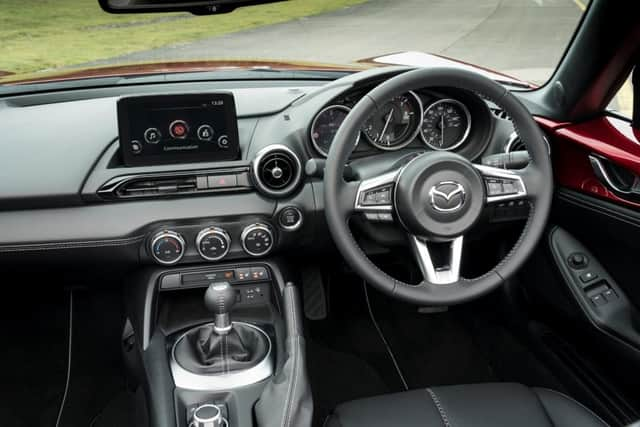Mazda MX-5 review - simple pleasures


Back when I was 17 I would have willing sold an internal organ or two for a Mazda MX-5.
Now, a little older and little wiser, my budget would probably allow me to secure a ratty used model or tie myself into a PCP deal on a new one.
Advertisement
Hide AdAdvertisement
Hide AdBut of course being older and wiser means I’ve got to think about things like getting the kids to school – not something a sporty two-seat roadster is much use for.
It’s still bloody good fun to zip around in for a week or two - as I was reminded when Mazda dropped off a demonstrator for me to test.


I drove the hard-top RF model previously but this test car was the more traditional soft-top version and had the larger, 181bhp 2.0-litre engine as opposed to the 130bhp 1.5-litre model I drove previously.
That means an improved, 6.5-second, nought to 62 time and an extra 10mph added to the top speed compared with the smaller-engined car.
Advertisement
Hide AdAdvertisement
Hide AdLike the 1.5-litre car, you need to rev the 2.0-litre MX5 close to the redline in order to get the most out of it. Even with the larger powerplant the MX-5 is a car built with a focus on exhilarating handling rather than out and out speed, but you do get more power in the mid-range than you do in the smaller car.
It makes more noise than the 1.5-litre version while idling - a suitably throaty sounding rumble - but I actually preferred the noise from the smaller engine when revving. The six-speed manual gearbox is quite simply driving perfection though and while you can spec the RF model with an automatic gearbox I can’t imagine why you would unless you had to.
Mazda MX-5
- Price: From £28,405
- Engine: 2.0-litre, four-cylinder petrol
- Power: 181bhp
- Torque: 151lb/ft
- Transmission: Six-speed manual
- Top speed: 136mph
- 0-62mph: 6.5 seconds
- Economy: 40.9mpg combined
- CO2 emissions: 155g/km
MX-5 has become a byword for great-handling sports car and when Mazda set out to design the original they took their inspiration from classic British models. Through the generations the 50:50 weight distribution and supple springs have remained a constant with the model and kept the car true to the original vision however much modern tech they cram into it.
Steering is pin sharp via an electrically-assisted rack and pinion set-up and the suspension is supple enough to be comfortable and controlled enough to be sporty. This is a car that’s supposed to be sporty and fun - not hardcore and Mazda have got it pretty close to being bang on.
Advertisement
Hide AdAdvertisement
Hide AdI say pretty close, because our test car was equipped with sports suspension and Bilstein dampers. It’s firmer and still supple but I preferred the standard suspension which soaked up the bumps and potholes of the Scottish roads more effectively and allowed a little more body roll in the corners.
The look and feel of the cabin is top notch and the sand leather seats and dash finish looks terrific in contrast to the ‘soul red crystal’ pearl metallic paint on our demonstrator. Cabin layout is logical - with the exception of the cupholders mounted to the rear bulkhead - and uncluttered but space is at a premium and if you’re taller than five feet 11 it’s going to be a squeeze.


It’s also very low, which adds to the go-kart feel while you’re driving, but even for my sprightly, five feet nine frame it was a challenge getting in and out.
Noise levels in the cabin are pretty good considering it’s a convertible, but there’s a noticeable rise in wind noise on the motorway in the soft-top compared with the RF model.
Advertisement
Hide AdAdvertisement
Hide AdBut that’s to be expected. You don’t buy a convertible roadster to be cocooned and insulated from the outside world.
You buy a two-seater roadster to have fun on the road and to put a smile on your face and starting at £23,800 (£28,405 for the 2.0) the MX-5 is one of the most cost-effective ways to do that in a new car.
Would I sell my kidney for one? Probably not until the kids have grown up but, after that, I might consider it.
This article first appeared on The Scotsman